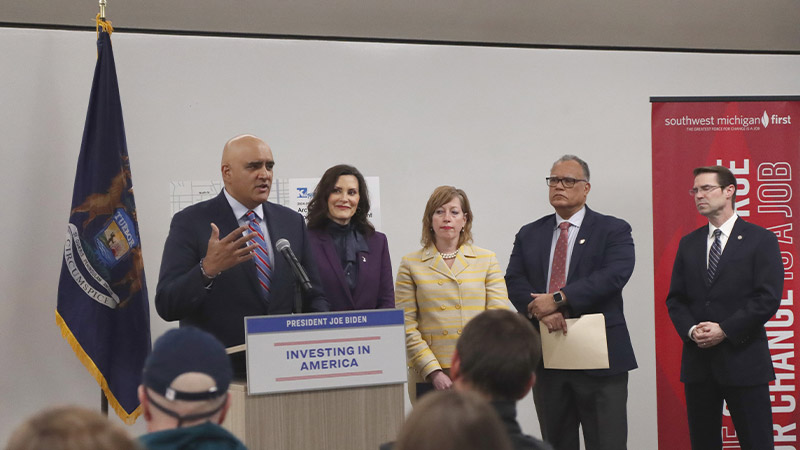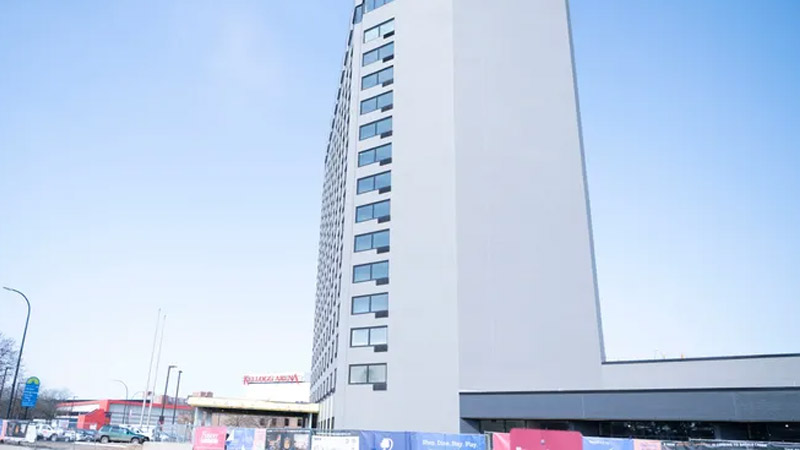The Southwest Michigan economy is often recognized for the strong roles that its pharmaceutical, medical device, furniture, agriculture, food processing, and manufacturing industries play.
But what about design?
Michigan, as a whole, is brimming with designers of all sorts: industrial, interior, graphic, fashion—you get the drift. According to 2017 data from the U.S. Bureau of Labor Statistics, Michigan is home to the country’s highest concentration of commercial and industrial designers, surpassing Ohio, Illinois, Texas, New York, and even California. Michigan has almost 40 percent more industrial designers than California and nearly 60 percent more than New York.
When zeroing in on Southwest Michigan, the concentration of commercial and industrial designers is even more striking. This is thanks, in large part, to the region serving as home to global companies such as Stryker and Newell Brands and smaller but still major players like Consort Display Group.
So, how did all those designers get here? It’s no surprise really. It all started with regional firsts and innovations in the pharmaceutical, medical device, furniture, agriculture, food processing, and manufacturing industries, of course. Southwest Michigan is a community famous for Checker cabs, parchment paper, the friable pill from the Upjohn Company, Shakespeare rods and reels, Gibson guitars, Dr. Homer Stryker’s turning bed frame, Whirlpool washing machines, Kellogg’s Corn Flakes, and the list goes on.
Today, you have to look no further than the more than 200 Southwest Michigan companies that incorporate design into their product delivery process, students of Western Michigan University’s (WMU) Richmond School of Design and Innovation, and annual MIX events attended by 1,000 area design professionals to see that design in Southwest Michigan not only exists—but thrives.
Don’t feel bad if you were surprised by design’s dominance in the area. We talked to several members of the Southwest Michigan design community who were unaware of it themselves and even looked elsewhere to find employment before returning to the region.
Personal Walkabouts
When Matt Giffels, principle UX/UI (user experience/user interface) designer at Stryker, left his home state of Michigan to start college in Florida, it was because he saw the move as his best chance at a career in an artistic industry. “My passion was always computers and art and games—anything where I could spend my time being creative and making things. In high school, I spent a ton of time in the art room, and when I went off to college, I knew I had to keep working in that creative realm.” Michigan, as Giffels saw it then, just wasn’t a place with the sorts of creative opportunities he needed.
For Roger Lepley, owner and president of Consort Display Group, the beginning of his career in architecture and industrial design began much the same as Giffels’ did—with him shipping out to seek creative work beyond the Mitten State. “I grew up in Kalamazoo, but I left to study architecture at the University of Colorado. At one point, I was actually drafted into the Army, where they put me to work in the Graphic Arts Department.”
Laurie Vennie’s path to the world of design took her, in some ways, even farther away from home base than Lepley’s or Giffels’. Vennie, director of usability and experience design at Newell Brands, started her career with a degree in biology. “When I went for undergrad, I’d made up my mind that my goal in life was to become a veterinarian. But at one point, I realized the path wasn’t so clear anymore. I went back to school and earned my master’s degree in multidisciplinary engineering with an emphasis on human factors engineering.” Vennie then left the state of Michigan.
Returning Boomerangs
It took Giffels nearly 15 years to return to Michigan. In his decade-and-a-half spent out of town, he worked mainly in video game design, on projects like NCAA Madden and Call of Duty. “I worked my way up to senior UX designer, although—for me—titles have always been somewhat irrelevant. Really, I was still doing lots of the usual [repetitive and tedious] work people tend to expect from designers.”
Things changed when Giffels had a child. “Ever since my child was born, coming back to Michigan was in the back of my mind. There was a point where I finally realized the work that I was doing wasn’t worth staying so far from my family, and I decided I’d move back to Michigan. I was pretty sure I wouldn’t find anything I wanted to do [in Michigan]—sort of like [how I felt] when I left initially—but I decided I’d move and figure the rest out later.”
And figure it out he did. “I just started applying everywhere—Meijer, Ford, Stryker, some other random spots—and then Stryker called.” Now, Giffels uses the creative perspectives he’s always had and the experience he’s gained over the years in a very different sector. “No matter my job title, the Adobe Suite has always been my second home—my first home, actually, in a lot of cases.”
In another fated change, the recession of 1981-1982 stunted construction projects in Michigan and that’s when Lepley’s career began a turn from architecture to industrial design. “Someone from Kalamazoo’s city council asked if I’d be willing to create some street banners like the ones they had in Chicago. At the time, Chicago was the only place with these banners. When the project was finished, I started to get all kinds of calls from all over the place—other cities that wanted banners of their own.”
So Lepley agreed, and he soon found himself busy enough to partner with a young graduate of WMU’s design program, who Lepley affectionately refers to as ‘Ed the Head.’ “Ed Tereshinski was a designer, but he could do anything,” Lepley explained. “For a long time, he was the head of every project we conducted.”
“And we kept at it,” Lepley continued. “We kept doing the little projects. We kept expanding, and eventually, we started to do the vast majority of our processes in-house. It got to the point where we had this whole team of people who could help in every stage of the process—and now we conduct business and work in design across the world.”
Vennie, who’d had a winding path of her own, also found herself called back to Southwest Michigan’s design community. “When I started at Newell Brands, none of this existed,” she said, gesturing to the building she works in now. “None of our team really even knew it was being built.” Though employed by Newell, Vennie had been living in Chicago. All of her teammates also worked remotely. But, when the building was ready, the move to Southwest Michigan wasn’t a hard sell. “I’m originally from St. Joe, so when they announced the new building, it just made sense that I’d move with the job.”
Vennie described what it was like when she and the rest of the Newell team arrived at the freshly-finished building. “None of us knew what to expect, not from the building, not from each other.” Not knowing one another’s primary disciplines and specialties from the get-go actually allowed the team to fall into a highly-collaborative rhythm, Vennie said. As most any design professional will tell you, design is all about solving problems. That, the Newell team did.
Mixing It Up
When asked about their connection to the greater community of designers who call Southwest Michigan home, Giffels, Lepley, and Vennie unanimously noted their desire for deeper involvement. While Giffels has a global network from his years in video game design, Lepley has close relationships with long-time colleagues, and Vennie benefits from her tight-knit professional community, each creative recognizes the importance of creating connections—especially in a rapidly-growing creative community.
And rapidly growing it is.
If you recall, back in 2017, Dan Guyette, dean of WMU’s College of Fine Arts, shared with 269 MAGAZINE that an undergraduate curriculum was in development for the then newly-unveiled Richmond Institute for Design and Innovation. Spurred by a $3 million gift from James and Lois Richmond and supported by companies like Whirlpool, Tekna, Newell Brands, Stryker, Fabri-Kal, Landscape Forms, and Eaton, the institute was poised to be one of the most dynamic and exciting programs anywhere.
In the spring of 2021, the first graduating class will go out into the community and begin their careers. These young professionals will have completed more than 125 credit hours over four years of hand-on industrial design education in 28,000 square feet of dynamic, open, and collaborative workspace. They will be well versed in curriculum that spans product design, art and design, engineering, art history, and entrepreneurial studies. Their presence in the community, and that of future cohorts, will further bolster Southwest Michigan’s status as a hub for design.
To bring students of regional design programs, individuals like Giffels, Lepley, and Vennie, and their thousands of peers across the region together, regional economic catalyst Southwest Michigan First created MIX. The initiative invites local creatives to come together for mixers, seminars, and workshops. “The name of MIX has homegrown roots: MI stands for Michigan, and X marks the spot where creativity happens,” said Petey Stephanak, partner at Southwest Michigan First.
MIX events, which run the gamut from learning to networking experiences, are open to anyone who has a passion for design. Discovery sessions offer panel discussions where area experts weigh in on specific areas of design, from problem-solving to the gig economy to how IoT (Internet of Things) will impact future living. There’s MIX Design Day, a day-long event where engineers from the automotive and medical device sector learn interactively alongside film and music makers. Plus, MIX hosts an end-of-year Innovation Celebration, which gives attendees an up-close look at the winning projects from students across WMU and K-12 schools.
Considering the availability of design jobs, the local university curriculum, and the host of curated events, it’s not hard to predict that Southwest Michigan’s design opportunities will continue to bring regional expats back.
“Looking at the area today, after coming back so much later, I’m realizing that there are a ton of design firms in the region,” Giffels reflected. “I grew up here and thought, ‘I have to leave and get out.’ But really, I’ve realized that everything I wanted, even back then, was already here for me.”




